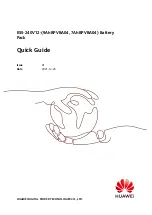
www.nationalrailwaysupply.com
2
01874C
b. Connect AC cord to selected 60 Hz voltage.
c. Charger will power up with no DC output,
unless programmed otherwise.
d. Program the controller for desired output
(see Programming functions).
e. Press voltage button to check for proper
polarity and battery voltage before starting
charge cycle.
f. Press START/STOP button to start charge
cycle.
g. Press current button to observe output
current and voltage button to observe
battery voltage.
h. Press START/STOP button to stop charger
when battery voltage and charge current
have reached desired level.
i. Make sure charger is stopped before
disconnecting AC cord and DC clamps from
battery.
j. If charger display shows an "Er" (error)
followed by a number, clear the error using
function 17 and try starting charge cycle
again. If an error returns, consult error code
descriptions.
3. DESCRIPTION
The NATIONAL RAILWAY SUPPLY battery charger
is a convection-cooled, solid state, SCR regulated
charger that provides either a constant current or
constant voltage output. It is designed to make
battery charging simple and has a variety of
programmable options to personalize the charge
profile. The charger can be programmed to charge
batteries within a cell range of 1 to 85 cells for gel-
cell, liquid lead-acid, valve regulated, nickel
cadmium and nickel iron batteries. The charger has
a comprehensive, self-checking diagnostic program
to monitor the quality of charge and check its own
safety conditions. A four-digit display will show
charge data, the programmed charger settings, and
error codes. These values are useful to monitor and
correct problems, if needed, with the charging
system and with the battery.
4. THEORY OF OPERATION
When the charger is connected to the desired AC
voltage source (208, 240 or 480), the transformer
creates auxiliary voltages for the electronic control
module. The electronic control module has a
microprocessor that controls and monitors the
charger so it will perform properly. The transformer
also supplies the power output used for charging the
batteries and provides electrical isolation between
the charger's output and the AC source.
The charger's output current flows through a shunt
and is sensed by the electronic control module along
with the chargers output voltage. These values are
converted into drive pulses for the SCRs by the
control module. The pulsating charge (a pulse
occurs each time an SCR is on) current is filtered by
the batteries to provide a smooth output.
The charger has an "IE" profile which is (a) High rate
constant current, and (b) Constant voltage. When
the charge is first started, the SCRs will conduct for
a certain portion of the sinusoidal anode voltage to
provide the required charging current at the low level
of battery voltage. In this start region, a constant
current is applied to the battery. The SCR
conduction will then increase as the battery voltage
increases in order to provide a higher output voltage
while maintaining a constant charging current.
When the battery voltage reaches the float voltage,
the SCRs will start to decrease their output. This
causes the charger to automatically change from a
constant current charge region to a constant voltage
charge region. As the batteries become fully
charged, the output current decreases. A
continuous constant float voltage will be supplied to
the batteries to maintain their charge until the charge
cycle is stopped.
The electronic control module also senses the
internal components of the charger for any change in
their performance. The charger's internal
temperature sensor will be used to protect the
charger from damage due to overheating. If the
internal temperature of the charger rises above 160
degrees Fahrenheit (
°
F), 71 degrees Centigrade
(
°
C), the charger will reduce its output current.
When the internal temperature reaches 170
°
F
(77
°
C), the charger will stop until the temperature is
reduced.
5. RECEIPT AND SET-UP OF THE CHARGER
Proper set-up of the charger is important in order to
achieve good charger performance and to prevent
damage to the charger and batteries.
When a charger is received, a check for possible in-
transit damage should be made. If any damage is
found, it should be reported as a claim to the carrier.
To permit free air flow for convection cooling, allow
three inches (3") minimum between the charger
sides and other equipment and four inches (4")
minimum on top of the charger.
WARNING: THE CHARGER MUST BE
PROGRAMMED FOR THE PROPER USER
SPECIFICATIONS BEFORE THE INITIAL
CHARGE IS STARTED
.

























